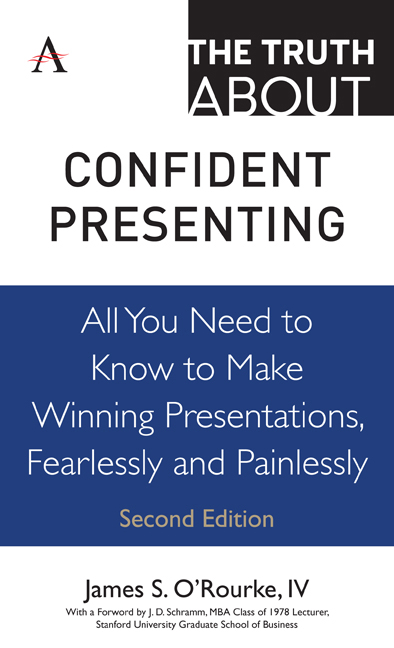 The Truth about Confident Presenting
The Truth about Confident Presenting Book contents
- Frontmatter
- Contents
- Foreword
- Introduction
- Part I Some Initial Truths
- Part II The Truth About Getting Ready to Speak
- Part III The Truth About What Makes People Listen
- Part IV The Truth About Developing Support for Your Presentation
- Part V The Truth About Getting Up to Speak
- Part VI The Truth About Managing Anxiety
- Part VII The Truth About Nonverbal Communication
- Part VIII The Truth About Visual Aids
- Part IX The Truth About Handling an Audience
- Truth 46 Assess the mood of your audience
- Truth 47 Answer the audience's questions
- Truth 48 Handle hostility with confidence
- Part X The Truth About What Makes a Presentation Work
- References
- Acknowledgments
- About the Author
Truth 48 - Handle hostility with confidence
from Part IX - The Truth About Handling an Audience
- Frontmatter
- Contents
- Foreword
- Introduction
- Part I Some Initial Truths
- Part II The Truth About Getting Ready to Speak
- Part III The Truth About What Makes People Listen
- Part IV The Truth About Developing Support for Your Presentation
- Part V The Truth About Getting Up to Speak
- Part VI The Truth About Managing Anxiety
- Part VII The Truth About Nonverbal Communication
- Part VIII The Truth About Visual Aids
- Part IX The Truth About Handling an Audience
- Truth 46 Assess the mood of your audience
- Truth 47 Answer the audience's questions
- Truth 48 Handle hostility with confidence
- Part X The Truth About What Makes a Presentation Work
- References
- Acknowledgments
- About the Author
Summary
Audience hostility generally comes in two forms: first, activities or actions on their part that may be distracting, annoying, rude or inconsiderate behavior. And second, audience members may have questions that challenge your authority, question your competence or are openly hostile to your subject or point of view. Let's deal with distractions first.
Late arrivals. Keep your promise to start on time, unless a key decision-maker is not yet in the room and starting without him would be pointless. If you start on time, you may find that some audience members arrive late and create a disturbance as they seek a seat and get settled. The best plan is generally to ignore all of that. They'll settle down in a few moments and you can move on. If the late arrival is an important person who deserves an update, you may wish to offer a very brief recap of key points you've discussed thus far, then move to your next point. Keep in mind that the majority of late arrivals are as embarrassed or self-conscious about the moment as you are.
Side conversations. Some audience-to-audience conversations are useful, as people help others in the room catch up or show them where to find certain information in your handouts. Other conversations, though, may be an indication that the audience is growing restless. If just two people in a conversation are a problem, you might try strolling closer to them without looking directly at them. As the audience begins to look in your direction as you move, the talkers will grow conscious that others are watching them, too, and likely will end the conversation.
If the audience is sending nonverbal signals that they're restless, unhappy or that their energy is flagging, you may need to provide them with a break for a few minutes. If that's not part of the presentation plan, you can acknowledge that there are other points of view or that some may disagree with the perspective you've offered. Then, tackle the disagreement head-on and explain why you chose a particular viewpoint.
Hostile or accusatory questions. If you receive questions from an 48 audience member that are openly hostile to you or to your material, address the issue that was raised and not the tone of the question.
- Type
- Chapter
- Information
- The Truth about Confident PresentingAll You Need To Know To Make Winning Presentations, Fearlessly And Painlessly, pp. 191 - 194Publisher: Anthem PressPrint publication year: 2019


